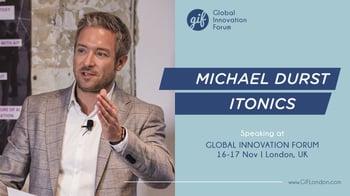Our monthly innovation updates provide you with an overview of the most relevant insights, best practices & tools from the innovation cosmos.
1. A Design x Future approach
"The best part of being a futurist is: It allows you to take proactive action in all parts of your work and organizations."
In the latest Innovation Rockstars podcast episode, Innovation Leader and Design Futurist Steve Fisher from McKinsey dives into futurology and foresight. The bestselling author of the book "The Startup Equation" recently wrote a report for McKinsey about a combined approach of design and futures thinking to prepare companies for the future. The report takes a behind-the-scenes look at major trends and their effects on business and society.
We have summarized the key takeaways for you:Futures thinking creates value
Incorporating futures thinking into the organization can lay the groundwork for moving forward into new markets and businesses with greater confidence and resilience. Foresight and futures thinking have proven over decades to create significant value for organizations when the results are incorporated into other functions such as innovation, R&D, marketing, M&A, and strategy. The relevance of the content also draws on an earlier study that says companies that practice corporate foresight experience 33 percent greater profitability than average companies and 200 percent greater growth. Future preparedness thus turns into a powerful predictor for becoming an outperformer in the industry.
Foresight reinforces (x) the impact of design
The Design x Future approach blends three approaches: strategic foresight, future design, and design thinking. The resulting end-to-end methodology helps uncover and monitor trends, scenarios, and speculative products and services, and provides organizations with an understanding of various possible futures toward which they may want to align their strategy or move away.
Strategic foresight is the systematic process of gathering future-relevant information (e.g. trends, emerging technologies), through environmental scanning activities, in order to extrapolate different plausible scenarios that could hold strategic relevance for an organization.
Future design is a design process that considers various possible futures when developing products and services. The approach assists companies in imagining new possible futures using techniques such as design fiction, future concepting, and speculative design. This can stimulate discourse about future products that we may or may not want to be based on their social, cultural, technological, and ethical implications.
Design thinking is a methodology for developing innovative concepts for complex problems. The focus is on the end user. Thanks to its open, flexible, and human-centered nature, design thinking has become a popular method for driving innovation.
The four phases of Design x Future
The Design x Future approach is organized into four phases. The initial phase focuses on scanning the environment and scouting for relevant influencing factors.
1. Trend research and synthesisTrend research and synthesis are about expanding the field of vision. The organization's market environment is searched for strong and weak signals that indicate future change and disruption. Patterns can then be derived from this information, revealing potential opportunities and risks.
2. Scenario planningScenario planning uses the knowledge gained in the first phase to outline possible futures. In doing so, it is important also to consider paths that deviate from the company's currently planned future. Only then can the company gain future viability.
3. Ideation and concept developmentWith the knowledge of possible future scenarios, the idea generation phase can then be kicked off. What impact will the insights gathered have on products and services? Which new customer needs must be served? The desired outcome of this phase should be prototypes that can be validated and tested for the identified future scenarios.
4. Strategy and backcastingThe final phase is then about continuously checking the actual developments against the concepts and scenarios developed. If necessary, these must then be adapted and integrated into the current strategy.
Download: The ultimate Foresight & Strategy Toolkit
Equip your organization with the foresight & strategy capabilities needed to anticipate, prepare for, and shape possible futures. Get the toolkit for free!
2. Four ways to cultivate innovation
We probably don't need to explain why being innovative is the key to survival for any organization, whether it's a startup, corporation, or non-profit. When speaking of “innovation", it’s not always about revolutionary new products or services. In its essence, innovation is the process of creating value for customers by applying novel solutions to meaningful problems.
A recent article by Forbes highlights that bringing the next big product to market is not enough to achieve sustained success. What matters is to adopt a culture of innovation throughout the entire organization. The article outlines four ways to foster such a culture in your organization:
1. Innovation starts at the top
It’s the top management’s job to establish a culture that encourages innovative thinking and participation across the entire organization. It takes the right mindset that great ideas can come from any department or employee level.
2. Allow space for innovation
To foster innovative thinking throughout a company, employees must have the space to think creatively beyond their primary roles. They must be provided with a set time frame per week or month to identify market problems and consider how they might address them. Such outside-the-box thinking could also be encouraged with idea challenges, for example, which shows employees that disruptive thinking is valued.
3. Reward successes
To motivate employees to concern themselves with anything beyond their functional roles and responsibilities, they need to be incentivized properly. Organizations need to establish a rewards and recognition system where employees are incentivized to identify pain points or opportunities while proposing disruptive solutions.
4. Curb the dissent
If you want to foster an innovation-first mentality throughout the organization, you should respond positively to ideas that are not so suitable. Idea owners should receive as much constructive feedback as possible and be encouraged to refine their ideas based on that feedback, rather than closing the door on an idea.
3. Our trend of the month: New Psyche
The study of psychedelic drugs and their ability to treat mental health disorders, substance abuse, and severe chronic pain continues to expand alongside our understanding of the mind. Once vilified as immoral and dangerous, psychedelics and micro-dosing practices are now being investigated by leading research institutions and startups worldwide—and initial trials are promising.
The resurgence of interest in psychedelic therapy, seen over the last five to ten years, is due in part to advances in technology (such as brain imaging) and molecular biology that help scientists to understand brain action and functioning better. Now backed by growing evidence, investment, and cultural acceptance, psychedelic therapy has the potential to change the course of psychiatry, public health, and the study of consciousness.
As the number of clinical studies, patents, and interested parties grow, funding is beginning to pour in and shape the industry's future. Recently, venture capital fund Palo Santo announced the closing of its $50 million fund that will back emerging psychedelic therapeutics companies to usher in “a new paradigm in wellbeing.” The fund already has a robust portfolio of over 20 companies across the psychedelic ecosystem, including Beckley Psytech, Tactogen, Bexson Biomedical, Gilgamesh Pharmaceuticals, Delix Therapeutics, and Fluence, among others.
Political and cultural attitudes towards psychedelic drugs are also relaxing, particularly in the countries conducting research. In 2020, the state of Oregon voted to decriminalize psilocybin—the ingredient that gives mushrooms their magic—and legalize it for therapeutic use. A growing number of American cities have likewise passed measures to decriminalize psilocybin drugs. Colorado will hold a similar vote on psilocybin in this November’s general election. And earlier this month, the government in Alberta, Canada announced it will begin regulating psychedelic drugs for therapeutic use.
As the psychedelics landscape diversifies, emphasis is shifting to patenting new methods of synthesizing these substances, differentiating between medical and recreational uses, and establishing private treatment clinics. The challenges ahead remain many, but the potential is immense and only beginning to gain recognition.
To explore other trends similar to New Psyche, check out the People Trend Radar containing 30 trends that represent the evolution of human behavior, social values, and demographics that define the relationship between businesses and customers.
4. Fact of the month: Flying car makes first public flights
| 90 seconds - that's how long the flying car from Chinese electric vehicle maker Ypeng Inc lasted. The test flight of the two-seater was conducted in Dubai and paves the way for the launch of the electric aircraft on the international market. |
5. Your monthly dose of innovation
This year has two more exciting innovation events in store for you, and ITONICS will be there to meet you.
The Innovation Roundtable Summit will take place with 600 corporate innovators from 250 multinational firms in Copenhagen from November 15-17. You can expect three highly interactive days of mutual exchange and learn about key innovation topics and challenges. On November 16, ITONICS innovation experts Sebastian Pfingsten and Alex Kruczek will give a track talk on "How to close the strategy to execution gap". Drop by and say hi!
 The Global Innovation Forum in London is finally back from November 16-17. Boost your creativity and get inspired by leading innovators, designers, creatives, entrepreneurs, and dreamers. ITONICS founder Mike Durst will join a 30-minute panel session on November 17 to discuss the topic of “Reshaping Corporate Culture for Driving Creativity”.
The Global Innovation Forum in London is finally back from November 16-17. Boost your creativity and get inspired by leading innovators, designers, creatives, entrepreneurs, and dreamers. ITONICS founder Mike Durst will join a 30-minute panel session on November 17 to discuss the topic of “Reshaping Corporate Culture for Driving Creativity”.






